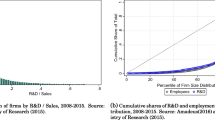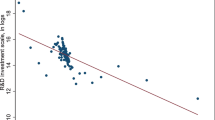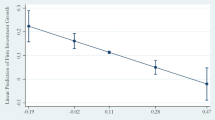Abstract
We analyse the financing of R&D activity in Italy, using data at firm level that cover a wide range of sources of financing, such as internal funds, bank loans and access to financial markets. Our analysis shows the importance of relationship lending in fostering innovative activities. The relation between innovative firms and their main bank tends to be relatively long lasting, permitting the bank to reduce information asymmetry, while low credit concentration is a common feature among these firms, presumably allowing them to attenuate hold-up problems. Nonetheless, firms that rely on bonds and outside equity financing tend to have a higher propensity to invest more in R&D, suggesting that relationship lending is only a partial substitute for access to stock and bond markets.
Similar content being viewed by others
Notes
As underlined by Audretsch et al. (2016), in the past, entrepreneurship and finance were usually considered as separate fields: on the one hand, entrepreneurial finance was primarily referred to early stage financing mechanisms, often supplied by the entrepreneur’s personal wealth or network; on the other hand, corporate finance literature often focused on publicly traded firms. However, the evolution of both the real economy and academic research has put in contact the two fields, given that agency problems and information asymmetries were recognized crucial for both of them. The difference mainly rests on the contractual solutions adopted to tackle these issues (the role of venture capital being more relevant among entrepreneurial firms than in large, established corporations). Therefore evidence gathered analysing the financing of innovation in established firms may inform the field of entrepreneurial finance: as highlighted by the above-mentioned authors, “new ways to finance entrepreneurial ventures may emerge at the crossroads between private and public equity”. See also Cumming and Vismara (2016).
In their review, Kerr and Nanda (2014) summarize the reasons why financing R&D projects should be distinct from financing other types of projects: (i) the innovation process is inherently uncertain; (ii) the fact that the return from the innovation process is extremely skewed and standard ways of evaluating projects are therefore very difficult; (iii) the innovator knows more about the project than the financier; (iv) firms engaged in innovation have a high percentage of intangible assets, and innovation is therefore an activity that cannot be easily collateralized.
Even if the relevance of the internal sources is consistent with the predictions of the Pecking Order Theory (POT), the POT is not fully suited to describe the financing process of innovations. In fact, while the POT may be thus synthetized: (i) internal sources, (ii) debt, (iii) new equity, in order to finance innovations, the recourse to stock markets should be preferable to debt finance and, in particular, to bank finance.
Gorodnichenko and Schnitzer (2010), using a broad sample of firms located in Eastern Europe and Commonwealth of Independent States, find that financial constraints restrain the ability of domestically owned firms to innovate and export and hence to catch up to the technological frontiers. For Europe, other analyses (Mohnen and Roller 2005; Savignac 2006; Mohnen et al. 2008) confirm that insufficient finance inhibits firm innovativeness. Magri (2007) emphasizes the difficulties encountered by small innovative firms. For a general review, see also Hall and Lerner (2009).
See also the discussion in Lerner et al. (2011).
However, the role of business angels, venture capital and crowdfunding is scarce in Italy, when compared to other industrialized Countries.
Based on the formulation of the question in the survey, R&D expenditures include services, both internally made and bought from external suppliers (make and buy); expenditures for vocational training are not included.
With discrete dependent variables, the standard linear probability model (LPM) estimated by OLS is inefficient: heteroscedasticity determines biased standard errors and erroneous hypothesis testing; furthermore, LPM can bring to predicted probabilities outside the 0–1 range.
Since the dependent variable is in logs, the coefficients represent semi-elasticities: a unity increase in the cash flow variable raises the dependent variable by 0.45 (45 %). We consider a standard deviation in the regressor, which is the classical variation used in the literature to perform sensibility tests. The result is equal to one standard deviation times the coefficient and percent, which corresponds to: 0.12 × 0.46 × 100 = 5.52.
In this case, we consider a discrete change of the dummy variable from 0 to 1, and the impact corresponds to the marginal effect reported in the table.
While our analysis focuses on the role of banks and relationship lending, it is more demanding to discuss the equilibrium amount of financing from inside and outside sources; in fact, these quantities are determined by both the supply and the demand of different types of sources (Cosh et al. 2009). It is hard to believe that firms can freely choose between alternative capital providers: in the presence of obstacles due to information asymmetries, entrepreneurs may in fact simply seek capital where it is most plentiful. Cosh et al. (2009) find that rejection rates are lower in credit markets than from other sources of capital, thus suggesting that financing choices owe to supply considerations as well as demand considerations. As acknowledged by Robb and Robinson (2014), it is challenging to separate supply and demand in the absence of some quasi-experiment.
References
Aghion, P., Bond, S., Klemm, A., & Marinescu, I. (2004). Technology and financial structure: are innovative firms different? Journal of the European Economic Association, 4, 277–288.
Alessandrini, P., Presbitero, A. F., & Zazzaro, A. (2010). Bank size or distance: what hampers innovation adoption by SMEs? Journal of Economic Geography, 10, 845–881.
Allen, F., & Gale, D. (1999). Diversity of opinion and financing of new technologies. Journal of Financial Intermediation, 8, 68–89.
Anton, J.J., & Yao, D.A. (1998). The sale of intellectual property: strategic disclosure, property rights, and incomplete contracts, working paper, The Wharton School, University of Pennsylvania.
Atanassov, J., Nanda, V., & Seru, A. (2007). Finance and innovation: the case of publicly traded firms, working paper, University of Michigan.
Audretsch, D., Lehmann, E., Paleari, S., & Vismara, S. (2016). Entrepreneurial finance and technology transfer. Journal of Technology Transfer, 41(1), 1–9.
Banca d’Italia (2009). Indagine sulle imprese industriali e dei servizi, Supplementi al Bollettino Statistico - Indagini campionarie, 38, luglio.
Benfratello, L., Schiantarelli, F., & Sembenelli, A. (2008). Banks and innovation: Microeconometric evidence on Italian firms. Journal of Financial Economics, 90, 197–217.
Berger, A. N., & Udell, G. F. (2006). A more complete conceptual framework for SME finance. Journal of Banking & Finance, 30, 2945–2966.
Bhattacharya, S., & Chiesa, G. (1995). Proprietary information, financial intermediation, and research incentives. Journal of Financial Intermediation, 4, 328–357.
Blass, A. A., & Yosha, O. (2003). Financing R&D in mature companies: An empirical analysis. Economics of Innovation and New Technology, 12(5), 425–447.
Bond, S., Harho, D., & Van Reenen, J. (2006). Investment, R&D and financial constraints in Britain and Germany. Annales d’Economie et de Statistique, Bol, 79–80, 1–28.
Boot, A. (2000). Relationship banking: what do we know? Journal of Financial Intermediation, 9, 7–25.
Brown, J. R., Fazzari, S. M., & Petersen, B. C. (2009). Financing innovation and growth: Cash flow, external equity, and the 1990s R&D boom. Journal of Finance, 64(1), 151–185.
Bugamelli, M., Cannari, L., Lotti, F., & Magri, S. (2012). Il gap innovativo del sistema produttivo italiano: radici e possibili rimedi. Questioni di Economia e Finanza—Occasional Paper, No. 121.
Chava, S., Chong, X., & Nanda, K.V. (2012). Funding innovation: the role of lender expertise and control rights. University of Miami, School of Business, working Paper.
Chava, S., Oettl, A., Subramanian, A., & Subramanian, K. V. (2013). Banking deregulation and innovation. Journal of Financial Economics, 109(3), 759–774.
Cornaggia, J., Mao, Y., Tian, X., & Wolfe, B. (2013). Does banking competition affect innovation? Journal of Financial Economics, 115(1), 189–209.
Cosh, A., Cumming, D., & Hughes, A. (2009). Outside entrepreneurial capital. Economic Journal, 119, 1494–1533.
Cumming, D.J., & Vismara, S. (2016). De-segmenting Research in Entrepreneurial Finance. Venture Capital. An International Journal of Entrepreneurial Finance. doi:10.2139/ssrn.2740453.
Detragiache, E., Garella, P., & Guiso, L. (2000). Multiple versus single banking relationships: theory and evidence. Journal of Finance, 55, 1133–1161.
Duranton, G., & Puga, D. (2001). Nursery cities: Urban diversity, process innovation, and the life cycle of products. The American Economic Review, 91(5), 1454–1477.
Fantino, D., Mori, A., & Scalise, D. (2015). Collaboration between Firms and universities in Italy: the role of a firm’s proximity to top-rated departments. Italian Economic Journal, 1(2), 219–251.
Ferri, G., & Rotondi, Z. (2006). Does finance matter in the respecialization of Italy’s industrial districts? In G. Bracchi a & D. Masciandaro (Eds.), XI report on the Italian financial system (pp. 397–433). Milan: Rosselli Foundation - Bancaria Editrice.
Giannetti, C. (2009). Relationship lending and firm innovativeness. Tilburg University, Discussion Paper, No. 2009/08.
Gorodnichenko, Y., & Schnitzer, M. (2010). Financial constraints and innovation: Why poor countries don’t catch up, NBER working Paper, No. 15792.
Hall, B.H. (1992). Research and development at the firm level: Does the source of financing matter?. NBER working Paper, No. 4096.
Hall, B.H., & Lerner, J. (2009). The financing of R&D and innovation. NBER working paper, No. 15325.
Hall, B. H., Lotti, F., & Mairesse, J. (2009). Innovation and productivity in SMEs: Empirical evidence for Italy. Small Business Economics, 33(1), 13–33.
Heckman, J. J. (1979). Sample selection bias as a specification error. Econometrica, 47, 153–161.
Herrera, A. M., & Minetti, R. (2007). Informed finance and technological change: Evidence from credit relationships. Journal of Financial Economics, 83, 223–269.
Himmelberg, C. P., & Petersen, B. C. (1994). R&D and internal finance: A panel study of small firms in high-tech industries. Review of Economics and Statistics, 76(1), 38–51.
Istat (2005). Distretti Industriali e sistemi locali del lavoro 2001–8° Censimento generale dell’industria e dei servizi. Rome.
Jones, A. M., & Labeaga, J. M. (2003). Individual heterogeneity and censoring in panel data estimates of tobacco expenditure. Journal of Applied Econometrics, 18(2), 157–177.
King, R., & Levine, R. (1993). Finance and growth: Schumpeter might be right. Quarterly Journal of Economics, 108, 717–737.
Lerner, J., Sorensen, M., & Stromberg, P. (2011). Private equity and long-run investment: The case of innovation. Journal of Finance, 66(2), 445–477.
Levine, R. (2005). Finance and growth: theory and evidence. In P. Alghion & S. Durlauf (Eds.), Handbook of economic growth (pp. 865–934). North-Holland: Elsevier Science.
Magri, S. (2007). The financing of small innovative firms: The Italian case. Bank of Italy Occasional Paper, No. 640.
Mann, W. (2014). Creditor rights and innovation: Evidence from patent collateral. University of Pennsylvania, Wharton School Working Paper, No. 1033.
Mohnen, P., Palm, F., van der Loeff, S., & Tiwari, A. (2008). Financial constraints and other obstacles: Are they a threat to innovation activity?, Technical Report No. 006, United Nations University.
Mohnen, P., & Roller, L. H. (2005). Complementarities in innovation policy. European Economic Review, 49, 1431–1450.
Mulkay, B., Hall, B., & Mairesse, J. (2001). Firm level investment and R&D in France and the United States: A comparison. NBER Working Paper No. 8038.
Kerr W.R., & Nanda, R. (2014). Financing innovation. NBER working Paper, No. 20676.
O’Sullivan, M. (2004). Finance and innovation. In J. Fagerberg, D. Mowery, & R. Nelson (Eds.), Handbook of innovation (pp. 240–265). Oxford: Oxford University Press.
Ongena, S., & Smith, D. C. (2000). What determines the number of bank relationships? cross-country evidence. Journal of Financial Intermediation, 9, 26–56.
Rajan, R. (1992). Insiders and outsiders: the choice between informed and arm’s length debt. Journal of Finance, 47(4), 1367–1400.
Rajan, R. (2012). The corporation in finance. NBER Working paper No. 17760.
Rajan, R., & Zingales, L. (2001). Financial systems, industrial structure, and growth. Oxford Review of Economic Policy, 17(4), 467–482.
Rajan, R., & Zingales, L. (2003). Banks and markets: The changing character of European finance, European Central Bank, 2nd Annual Conference.
Robb, A. M., & Robinson, D. T. (2014). The capital structure decisions of new firms. Review of Financial Studies, 27(1), 153–179.
Savignac, F. (2006). The impact of financial constraints on innovation: Evidence from French manufacturing firms. Cahiers de la Maison des Sciences Economiques No. 06042, Université Panthéon-Sorbonne (Paris 1).
Sharpe, S. (1990). Asymmetric information, bank lending and implicit contracts: A stylized model of customer relationships. Journal of Finance, 45(4), 1069–1087.
Ughetto, E. (2008). Does internal finance matter for R&D? New evidence from a panel of Italian firms. Cambridge Journal of Economics, 32(6), 907–925.
von Rheinbaben, J., & Ruckes, M. (2004). The number and the closeness of bank relationships. Journal of Banking & Finance, 28, 1597–1615.
Wooldridge, J. M. (1995). Selection corrections for panel data models under conditional mean independence assumptions. Journal of Econometrics, 68(1), 115–132.
Wooldridge, J. M. (2002). Econometric analysis of cross section and panel data. London: The MIT Press Cambridge.
Author information
Authors and Affiliations
Corresponding author
Additional information
The authors wish to thank Antonio Accetturo, Raffaello Bronzini, Paola Brighi, Andrea Caggese, Luigi Cannari, Francesca Lotti, Massimo Omiccioli, Silvia Magri, Marcello Pagnini, Alessandro Sembenelli, Giuseppe Torluccio, Salvatore Torrisi, Alberto Zazzaro, the participants at seminars held at the Bank of Italy and at the University of Bologna, and two anonymous referees for helpful comments. The authors alone are responsible for any errors. The views expressed in this paper do not necessarily reflect those of the Bank of Italy.
Rights and permissions
About this article
Cite this article
Micucci, G., Rossi, P. Financing R&D investments: an analysis on Italian manufacturing firms and their lending banks. Econ Polit Ind 44, 23–49 (2017). https://doi.org/10.1007/s40812-016-0056-3
Received:
Revised:
Accepted:
Published:
Issue Date:
DOI: https://doi.org/10.1007/s40812-016-0056-3




